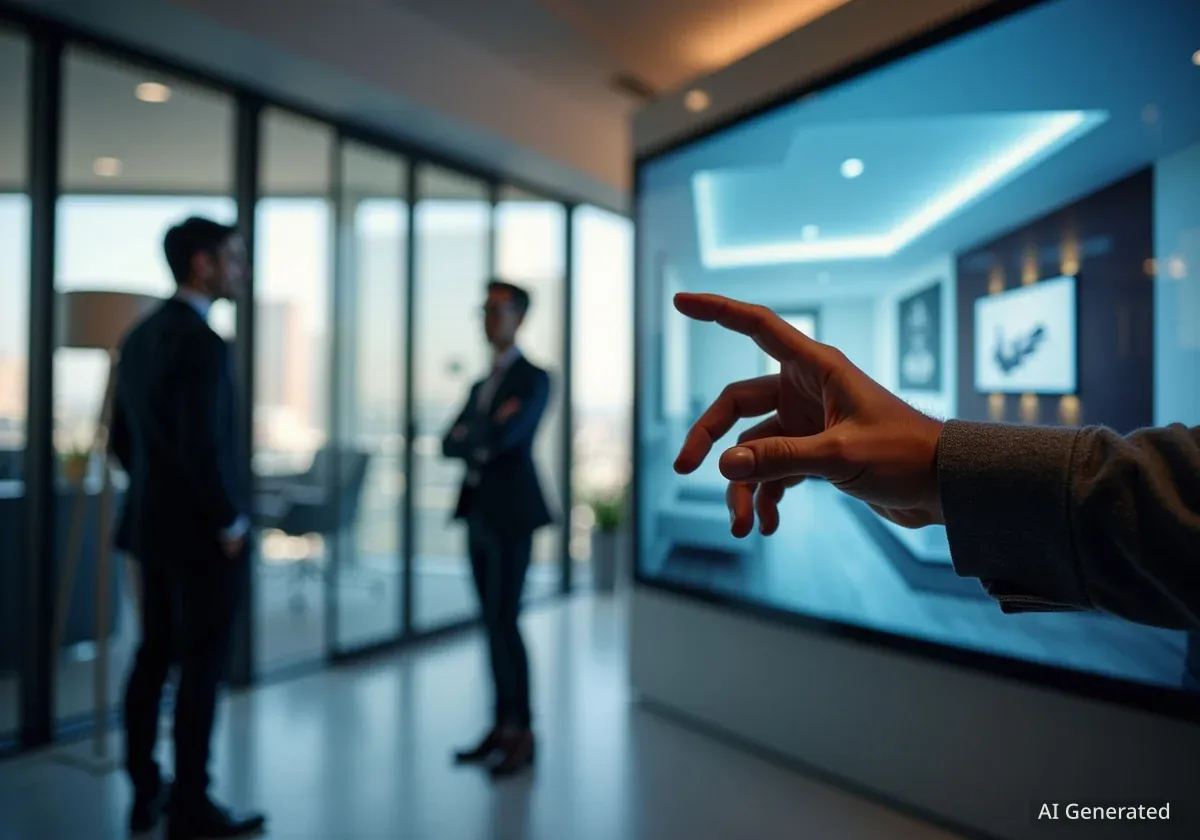Graphic design plays a crucial role in shaping interior spaces, influencing everything from overall mood to specific material choices. This discipline, often seen as separate, actively guides how environments are conceived, designed, presented, and experienced. Experts highlight its growing importance in creating cohesive and impactful interior projects.
Key Takeaways
- Graphic design principles like balance and rhythm are fundamental to interior design.
- It influences color palettes, typography, and wayfinding in physical spaces.
- Subtle or 'invisible branding' integrates graphic elements into interiors without overt logos.
- Visual trends from graphic design directly impact interior aesthetics.
- Graphic design skills are essential for client presentations and project pitches.
- Technology, including AI, has transformed the tools used by interior designers.
The Shared Visual Language of Design
Both graphic design and interior design rely on similar core principles. These include balance, rhythm, proportion, visual hierarchy, contrast, unity, emphasis, and detail. These shared foundations create a natural connection between the two fields. In both cases, visual elements work to guide the eye, establish a mood, and communicate specific messages to an audience or user.
Color palettes developed for brand identities now frequently inform interior schemes. Typography selected for corporate communications influences wall graphics, signage, and even the style of furniture within a space. The ability of graphic designers to create unified visual systems is invaluable when designing interiors that need to function as a single, consistent experience.
"The link between graphic design and interior design is like a beautifully choreographed dance: one defines the voice, the other creates the stage," says Marie Soliman, founder and creative director of Bergman Design House. "In 2025, that relationship feels more intertwined than ever. Graphic design doesn’t just decorate walls anymore, it informs brand storytelling, wayfinding, material choices, and even the emotional temperature of a space."
Design Synergy
According to industry experts, approximately 85% of visual design principles are shared between graphic and interior design disciplines, fostering seamless integration.
Invisible Influence in Everyday Spaces
Graphic design is present in nearly all commercial and public spaces, even when its presence is not immediately obvious. From hotels and restaurants to offices and train stations, its elements guide interactions. The typography that directs visitors, the color palette that sets an emotional tone, and the visual rhythm that makes a space feel coherent are all results of graphic design principles being applied to interior practice.
Sophie van Winden and Simone Gordon, founders of Owl Interior Design, observe this widespread influence. They note that graphic design shapes how projects are pitched, how mood boards are presented, and how spaces are shared on social media. For commercial projects, this goes further, with environmental branding, signage, and digital layers combining to tell a brand’s story. They describe graphic design as "the glue that holds concept and experience together."
Environmental Branding
Environmental branding involves integrating a brand's visual identity directly into a physical space. This includes signage, wall graphics, and even the choice of materials and lighting to create an immersive brand experience. It goes beyond simple logos to define the entire atmosphere.
Chris Trotman, creative director at Run for the Hills, specializes in what he calls "invisible branding." He believes that most people are more design-savvy than they might appear. They can sense when there is a disconnect between a brand and its interior, even if they cannot identify the exact reason. This subconscious awareness highlights the power of subtle design integration.
Trotman emphasizes that graphic design and branding significantly contribute to the ambiance of an interior space. All brand touchpoints, from menus to wayfinding signs, can reinforce a brand's story and enhance its "brand world." His firm aims to intertwine interior and graphic design, embedding brand elements subtly into fabrics or art, avoiding overt logo placement for a more timeless feel.
Trends and Their Crossover Impact
Visual trends in graphic design often transition directly into interior aesthetics. Marie Soliman points to the rise of layered typography influencing wall treatments and signage. She also notes how bold, gradient-driven color palettes have inspired immersive feature walls and custom finishes. Her firm has even borrowed from editorial layouts to create "spatial chapters" within buildings, each with its own distinct tone, rhythm, and texture.
The rapid spread of trends has been accelerated by social media and the internet. Sophie and Simone explain that graphic design trends, such as fonts, color palettes, and organic linework, frequently jump from design mood boards to wall murals, fabrics, or furniture shapes. The concept of an "Instagrammable moment" is now a common request in design briefs, emphasizing the visual appeal of spaces for digital sharing. They stress that the strongest interiors draw inspiration from graphic design, fashion, art, and digital culture, seeing it all as part of one unified creative language.
Trend Acceleration
The internet and social media have reduced the time it takes for a visual trend to spread globally by an estimated 70% compared to previous decades.
Chris Trotman views this as a global cultural shift but cautions against blindly following trends. He observes global trends originating in areas like catwalk fashion or films, which then influence graphics and interiors. For example, a 1970s trend might lead to retro color palettes and patterns. However, he warns that being too "trendy" can cause a project to become outdated quickly. His approach is to add a unique spin to trends to ensure a more timeless design.
The Presentation Revolution
Graphic design's influence is perhaps most evident in how interior projects are conceptualized, pitched, and sold. The visual standards established by graphic design have significantly raised client expectations. Interior designer Sarah Walter Boyd highlights the importance of personal branding for design firms. In a competitive market, a strong brand identity, conveyed through a website, logo, and even the font used in proposals, can differentiate a firm.
Boyd recalls a client remarking, "They’re buying into you – so they need to know what you're about and that you’re what they want." This underscores the need for a cohesive visual identity in early client engagement. Project presentations are where graphic design can truly determine the success of a pitch. Historically, designers might have presented hand sketches and physical samples. Today, technological advancements have dramatically expanded the tools available.
"You may have conjured a stunning room scheme, but if any presentation used to convey the scheme is poorly thought through or executed, you risk losing that client," Sarah Walter Boyd states.
She emphasizes that presentations must be sharp, with images aligned correctly and effective use of fonts and layout. This prevents visual distractions and ensures the client focuses on the design concept itself. Sophie and Simone agree that client expectations have transformed. They note a shift from hand sketches and fabric swatches to digital-first presentations, including immersive visuals, videos, and pitch decks that resemble glossy magazine spreads. The demand for polish and storytelling in presentations has increased significantly.
The Evolution of Design Tools
Graphic design has not only influenced interior design aesthetically but has also reshaped the professional toolkit. Interior designers now routinely use software originally developed for graphic designers. Chris Trotman recommends InDesign for client presentations, calling PowerPoint "limiting and not very professional." He also suggests Photoshop for image manipulation, such as recoloring mood board images or cutting out elements with ease.
The increased adoption of tech skills in interior design demonstrates graphic design's vital role in contemporary practice. Sophie and Simone recommend a balance of professional-grade tools with more accessible platforms. They list CAD platforms like Vectorworks or SketchUp as essentials, along with 3D rendering tools that quickly visualize ideas. They also find platforms like Canva useful for quickly and clearly presenting concepts to clients.
Software Adoption
A recent survey indicates that over 60% of interior design firms now regularly use graphic design software like Adobe Photoshop and InDesign for their projects.
Sarah Walter Boyd agrees that the skills required for interior designers are constantly evolving due to technology. She recalls that in 2009, assistants primarily needed Microsoft Office skills. Image integration involved physically cutting and pasting onto backing boards, which, while layered, risked damage from mistakes. Over time, Photoshop and PowerPoint became standard. Today, a full understanding of the Adobe Suite and CAD software is considered essential.
While AI has made graphic design capabilities more accessible, Chris Trotman believes a human touch remains critical. He notes that new AI features can perform tasks in Photoshop with minimal prompts. However, he stresses that AI lacks taste, meaning a human designer's eye and judgment will always be necessary. This ensures that the aesthetic and emotional impact of a design remain intentional and refined.
A Transformed Profession
Marie Soliman describes today’s interior designer as a "part storyteller, part strategist, part technologist, even sometimes psychologist." Designers need artistic sensitivity, organizational skills, and the agility to work with digital tools, from 3D visualization and parametric modeling to AI-assisted mood boards. Yet, she emphasizes that these tools do not replace the unique value of human interaction, such as hand sketches, conversations with artisans, or physically experiencing a space.
Marie also observes that the traditional boundaries between graphic and interior design have largely disappeared. When she founded Bergman Design House, the disciplines felt more separate. Now, a shared visual language exists, and graphic identity is often considered alongside interior architecture from the project's beginning. She concludes that whether on a page or in a room, design is about creating connections and memorable experiences. This shared mission has brought graphic and interior design closer than ever in 2025.




